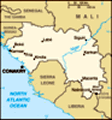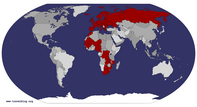Advertisement

 big cave
big cave
apparently the first humans in the region lived here I was scrambling up the side of a Guinean mountain when…when I realized the faint game-like trail I was following had disappeared under a small avalanche of rocks. Looking back out across the valley I had just traversed, the few tiny huts and peanut fields of the last village before the mountain were barely visible amongst the vast green forest below. After unsuccessfully searching the area for the continuation of the trail, it seemed the options were either to return down the steep slope, defeated, back to the last village, or try to push forward and get a vantage point from the mountain’s top, which it seemed couldn’t be far off. I had hiked over 30 km that day and the only people I had encountered were in the villages, so the thought of two people appearing on the trail, sharing mangos, and patiently guiding me the rest of the way to the next village was completely unpredictable. But that is precisely what happened: two men each carrying 10 ft long poles on their shoulders, who had started that morning at the Senegalese border and were walking at least 55 km to sell whatever it was they were carrying, appeared
seemingly out of nowhere and led the rest of the way along the difficult trail. And this is exactly how the entire three weeks I spent hiking across the Fouta Diallon in Guinea continued: bewildering chance occurrences that were always a combination of the over-the-top hospitality and kindness of the people, the magic of Guinea, and the sort of continual ‘luck’ that one can only experience when they let go and put their full confidence into the world.
Let me take a few steps back to the end of my last entry. After a few days in Tambacounda, which I will always remember as being the hottest place imaginable, I hit the road south through Niokola-Koba park (no lion-encounters, unfortunately) and after many hours of walking hitched a ride with the only Senegalese person I have met who is fluent in Japanese (he works with the Japanese government, which funds a surprisingly large number of aid projects in West Africa). Spent a few days at his hospital-construction site in Saraya, then onto Bembou for a few days with Kellen from Peace Corps learning about their projects, and finally back to Kedougou and the road south towards Guinea. It took
a full day of walking, dusk until dawn, to reach the first village, and I had no idea what kind of reception I would receive considering not only (thanks to the upcoming elections) that Guinea is currently rated by the government of Canada to be as dangerous as Somalia, but also because I was attempting to enter without any of the required documentation. I walked into the town, told the gendarmerie about my trip, and they’d soon stamped my passport, brought juice, fresh bread and mangos, let me have a refreshing shower and given me a personal hut for the night; they even changed my CFAs into Guinean francs at a better-than-normal exchange rate.
After that perfect introduction to Guinea came the mountainous day with the pole-men, which ended at a breathtaking village filled with ripe mango trees and with a view of the entire valley below. I walked into the village, tired, and after repeating “chef de village” to several people and the group of following children, was led to woman’s house who made me a bed and a wonderful dinner, despite the complete lack of verbal communication. Hiking-blisters kept me there for two days, and I helped
plant corn, cook, and eat mangos. It is wonderful to be in a village that can only be reached by scaling the side of a mountain, even if the villagers make it look easy as they glide up and down balancing large packages on their heads.
After the mountain-village it was another uphill day to reach Mali-ville, where a newfound friend put me up for the night and the next day taught me to drive a motorcycle; the few rides which I was able to hitch in Guinea were almost exclusively on the back of motorcycles, which was of course awesome, but that day riding along the winding dirt road through the green hillsides, in full control of the bike - that was awesome.
Next it was a hitched motto ride to the region’s capital, Labe, and then on foot in search of the Chutes de Saala, some waterfalls I had heard about. Started at 7 a.m. and walked 33 km subsisting completely on the delicious fruit from the ripe mango trees that lined the road. Finally arrived at the start of the path that branched off towards the falls, and had another ‘African-magic’ moment when within
literally 1 minute of reaching the path, Rassak, the Rasta guide to the area came by on his motorcycle, en route to the falls. He offered a ride, and 15 minutes later was guiding me literally through the river and down two of the three tiers of the falls to reach the final tier where the river plunges straight down 200 metres below into a lush, rainforest valley untouched by humans and home to chimpanzees and all sorts of other fascinating creatures. Bathing there in that last pool on the edge of the final drop, sun shining, staring out over the jungle below and colourful birds soaring high above, is one of the most beautifully peaceful experiences imaginable.
This is Africa.
After the falls Razzak invited me to stay with him and his family in the nearby village of Djaré for a few days of exploring the land and learning about wild fruits and life of the Pulaar people in the Fouta. On paper, Guinea may be an very poor country; but in reality it is only poor governing that is the problem. Walking through Djaré you can see the rich abundance of mangos, papayas, coconuts, avocados, oranges,
mandarins, bananas, cashews and cashew apples, pain de singe, fresh honey, maize, flour, rice, manioc, potatoes, peanuts, and palms for palm-oil and palm-wine; the water is drinkable straight from the well and the goats, sheep, cows and chicken are all wed fed. Even if you are lost in the forest you won’t go hungry thanks to the wonderful naré, mada, wild-manioc and variety of other wild foods that are the diet of the chimpanzee. And if food is not enough, Guinean soil is filled with diamonds, bauxite and many other valuable exports, although here’s to hoping that if those resources are ever tapped it’s done so in a way that conserves the jungle and way of life of the people here.
After Djaré it was time to head back to mountainous foot paths winding through tiny villages inaccessible by vehicle or bicycle, for a week long series of steep, 25 to 40 km days passing Leluma, Malanta, Touba, Councitel, Gaoul, and all the villages in between. And the magic continued: it seemed that every time I got thirsty, I would find a well; every time I got hungry, I would pass one of the fruit trees Rassak had taught
me about; every time I thought I lost the path, someone would come along out of the blue and point me in the right direction. There were many offers of places to stay and delicious meals, requests that often went something like “please stay here with us, my family have never been near a white person before”. Often times children (and occasionally adults) are scared or even terrified, bolting in the other direction when they see me on the path; and in villages the older children like to amuse themselves by trying to drag the younger, terrified ones toward me. But after a few hours of keeping their distance, sitting a few meters away staring intently, the kids start to warm up, and usually by the end of the night I am teaching karate and singing and dancing with them - anything from salsa and hip hop (some of the best moments are when I attempt to teach c-walking to the sounds of Bob Marley), to my comic version of mbalax/sabar, to ‘interpretive dance’ to the tune of my own whistling. It is all quite funny to me and seemingly intriguing to them, but hey, whatever it takes to break
the ice and make some good memories.
Coming out of the mountains I decided to start heading back north, through Bissau and the Casamance, to Gambia. My last week in Guinea was happily across flatter lands (by this point ‘hitchhiking across Africa’ had officially become ‘walking across Africa and accepting rides if someone offers’) and filled with more wonderful hospitality, weddings, plus amazing, packed, high energy clubs in tiny villages where the only electricity is by generator (even got in a Sabar circle like the one in the previously posted video). Also, it was this leg of the Guinea experience that was the height of the mango-rich experience. I had no idea how many different varieties of mangos there are in that wonderful country, but there was one village in particular - Ndioriah - where as soon as the villagers found out I liked mangos they spent two days bringing me all sorts of varieties: giant football-sized and extra juicy, papaya or apple flavored, tiny supremely delicious mangos that you can bite right into, red ones, yellow ones, green ones, plus dried mangos and unspeakably scrumptious mango sauce….mmmmmmmmango.
After the mango experience, it was time to move on;
left Guinea and spent two days walking into Guinea-Bissau, only to be kicked back out again: the clandestine-entrance that had worked in Guinea-Conakry didn’t march there, and 100 euros for the visa was again out of the question. So back to Guinea and another few days of walking to the Senegalese border, and then on toward the ‘rebel-disputed Casamance’ (everything is completely at peace here). After a few days in Ziguinchor relaxing Rastafari style with another Bifal friend whose sister had randomly invited me in, taking in the World Cup (Ghana…Cote D’Ivoire…Cameroon!!! …and Germany, what happened!?), it was finally back to the ocean. Here in Cap Skiring with its sandy beaches, palm forests, and tranquil mangroves I am staying with a friend of a couchsurfer. There are coconuts, papayas, bananas, and yes, mangos, outside my window, plus a friendly monkey (although he slapped me in the face today when I tried to grab a coconut he was playing with), and a 5 minute walk to the beach. All this on a few dollars a day, and still completely via hitchhiking/walking and without ever staying in a hotel - trust in Africa, trust in the road and in life; keep your
head up, but trust - it’s worth it 😉
Advertisement
Tot: 0.26s; Tpl: 0.016s; cc: 13; qc: 69; dbt: 0.0687s; 1; m:domysql w:travelblog (10.17.0.13); sld: 1;
; mem: 1.2mb


























Jessica Taylor
non-member comment
: )
awe. you look so happy. and like you are having fun! btw. i love your hair. : )